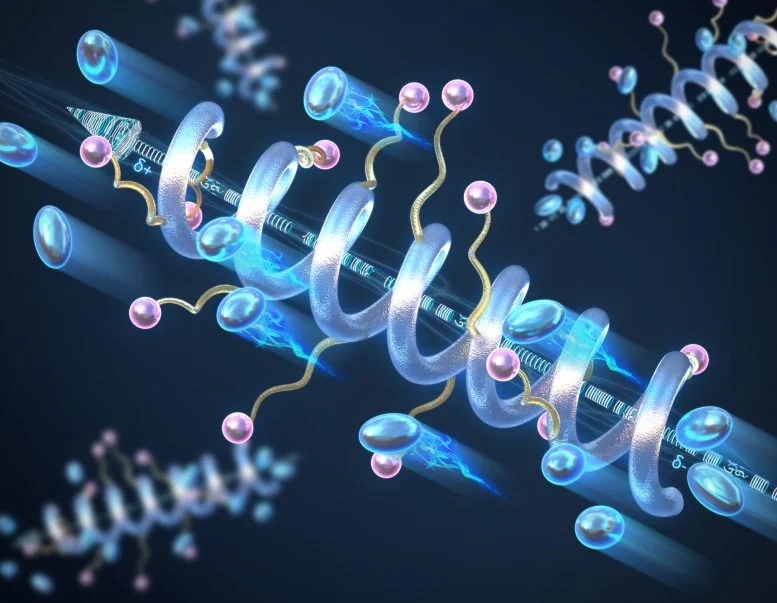博文
革命性的电池技术:螺旋聚合物开启新一代固态电解质
 精选
精选
||
革命性的电池技术:螺旋聚合物开启新一代固态电解质
诸平
据美国伊利诺伊大学格兰杰工程学院(University Of Illinois Grainger College Of Engineerin)2024年8月14日提供的消息,革命性的电池技术:螺旋聚合物开启新一代固态电解质(Revolutionizing Battery Tech: Helical Polymers Unlock Next-Gen Solid-State Electrolytes)。
美国伊利诺伊大学厄巴纳-香槟分校(University of Illinois Urbana-Champaign, Urbana, IL, USA)的研究人员与中国杭州西湖大学(School of Engineering, Westlake University, Hangzhou, China)的程建军(Jianjun Cheng)博士合作,已经开发出螺旋结构的肽聚合物电解质(peptide polymer electrolytes),与传统的随机线圈结构(“random coil” structures)相比,它具有优越的导电性和稳定性。这些螺旋聚合物提高了固态电池的性能,并且环保,因为它们可以在使用寿命结束后分解和回收。相关研究结果于2024年8月6日已经在《自然材料》(Nature Materials)杂志网站在线发表——Yingying Chen, Tianrui Xue, Chen Chen, Seongon Jang, Paul V. Braun, Jianjun Cheng, Christopher M. Evans. Helical peptide structure improves conductivity and stability of solid electrolytes. Nature Materials, 2024. DOI: 10.1038/s41563-024-01966-1. Published: 06 August 2024. https://doi.org/10.1038/s41563-024-01966-1
几十年来,研究人员一直在探索固态电解质作为储能系统的潜在组件,特别是用于开发固态电池。与传统的液体电解质相比,这些材料是更安全的替代品。传统的液体电解质是一种允许离子在电池中移动的溶液。然而,需要新的概念来推动当前固体聚合物电解质的性能,使其适用于下一代材料。
伊利诺伊大学厄巴纳-香槟分校的材料科学与工程研究人员探索了螺旋二级结构对固态肽聚合物电解质导电性的作用,发现与随机线圈相比,螺旋结构的导电性大大增强。他们还发现,更长的螺旋导致更高的导电性,螺旋结构增加了材料对温度和电压的整体稳定性。
上述论文的通讯作者、领导这项工作的克里斯多夫·埃文斯教授(Professor Christopher M. Evans)说:“我们引入了使用二级结构——螺旋——的概念来设计和改进固体材料中离子电导率的基本材料特性。它和生物学中多肽的螺旋结构是一样的,我们只是出于非生物学的原因使用它。”
由于螺旋结构的增强(Enhancements Due to Helical Structures)
聚合物倾向于采用随机结构,但聚合物的主干可以被控制和设计成螺旋结构,就像DNA一样。因此,聚合物将具有大偶极矩,即正负电荷的大规模分离。沿着螺旋的长度,每个单独肽单元的小偶极矩将加起来形成大偶极子,这增加了整个结构的电导率和介电常数,并改善了电荷传输。电导率和介电常数这些指标也是材料储存电能的能力的衡量标准,肽链越长,螺旋结构的导电性越高。
克里斯多夫·埃文斯补充说:“这些聚合物比普通聚合物稳定得多,螺旋结构非常坚固。与随机线圈聚合物相比,你可以在高温或高压下使用,它不会降解或失去螺旋结构。我们没有看到任何证据表明此类聚合物在我们希望它分解之前就会分解。”
此外,由于这种材料是由肽类制成的,当电池失效或达到使用寿命时,可以使用酶或酸将其降解回单个单体单元。此类原材料可以在分离过程后回收再利用,减少对环境的影响。
这项研究得到了美国国家科学基金会的部分支持,分别用于肽类物质的合成和聚合离子液体物理{United States National Science Foundation (NSF CHE 17-09820 and CHE 19-05097 for peptide synthesis, and DMR-1751291 for polymerized ionic liquid physics)}。这项工作也得到了美国能源部(US Department of Energy)、基础能源科学办公室(Office of Basic Energy Science)、材料科学与工程部门的部分支持,项目编号为#DE-SC0020858,用于离子电导率和电介质测量{ US Department of Energy, Office of Basic Energy Science, Division of Materials Sciences and Engineering under award #DE-SC0020858 (ionic conductivity and dielectric measurements)}。
上述介绍,仅供参考。欲了解更多信息,敬请注意浏览原文或者相关报道。
Ion transport is essential to energy storage, cellular signalling and desalination. Polymers have been explored for decades as solid-state electrolytes by either adding salt to polar polymers or tethering ions to the backbone to create less flammable and more robust systems. New design paradigms are needed to advance the performance of solid polymer electrolytes beyond conventional systems. Here the role of a helical secondary structure is shown to greatly enhance the conductivity of solvent-free polymer electrolytes using cationic polypeptides with a mobile anion. Longer helices lead to higher conductivity, and random coil peptides show substantially lower conductivity. The macrodipole of the helix increases with peptide length, leading to larger dielectric constants. The hydrogen bonding of the helix also imparts thermal and electrochemical stability, while allowing for facile dissolution back to monomer in acid. Peptide polymer electrolytes present a promising platform for the design of next-generation ion-transporting materials.
https://blog.sciencenet.cn/blog-212210-1446827.html
上一篇:低脂纯素饮食最适合减肥,比地中海饮食效果更好
下一篇:研究人员发现男性后代接触塑料与自闭症之间的惊人联系
